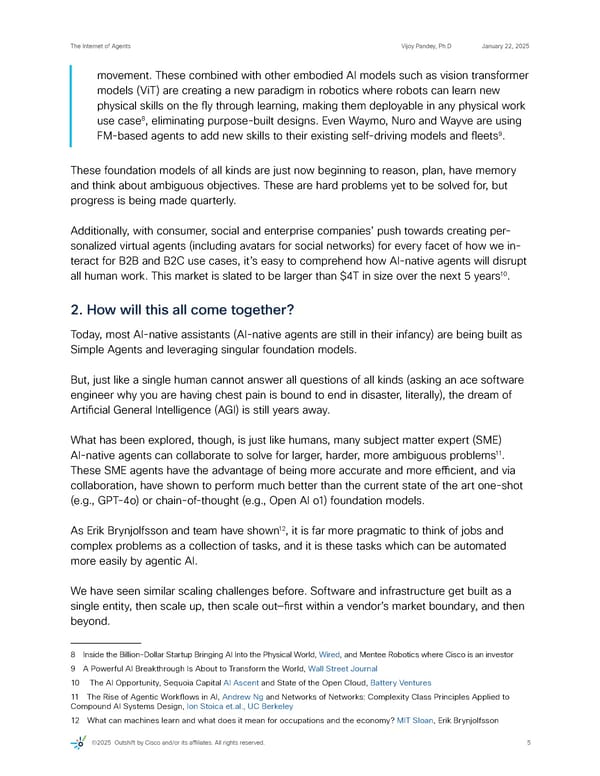The Internet of Agents Vijoy Pandey, Ph.D January 22, 2025 movement. These combined with other embodied AI models such as vision transformer models (ViT) are creating a new paradigm in robotics where robots can learn new physical skills on the fly through learning, making them deployable in any physical work 8 use case , eliminating purpose-built designs. Even Waymo, Nuro and Wayve are using 9 FM-based agents to add new skills to their existing self-driving models and fleets . These foundation models of all kinds are just now beginning to reason, plan, have memory and think about ambiguous objectives. These are hard problems yet to be solved for, but progress is being made quarterly. Additionally, with consumer, social and enterprise companies’ push towards creating per- sonalized virtual agents (including avatars for social networks) for every facet of how we in- teract for B2B and B2C use cases, it’s easy to comprehend how AI-native agents will disrupt 10 all human work. This market is slated to be larger than $4T in size over the next 5 years . 2. How will this all come together? Today, most AI-native assistants (AI-native agents are still in their infancy) are being built as Simple Agents and leveraging singular foundation models. But, just like a single human cannot answer all questions of all kinds (asking an ace software engineer why you are having chest pain is bound to end in disaster, literally), the dream of Artificial General Intelligence (AGI) is still years away. What has been explored, though, is just like humans, many subject matter expert (SME) 11 AI-native agents can collaborate to solve for larger, harder, more ambiguous problems . These SME agents have the advantage of being more accurate and more efÏcient, and via collaboration, have shown to perform much better than the current state of the art one-shot (e.g., GPT-4o) or chain-of-thought (e.g., Open AI o1) foundation models. 12 As Erik Brynjolfsson and team have shown , it is far more pragmatic to think of jobs and complex problems as a collection of tasks, and it is these tasks which can be automated more easily by agentic AI. We have seen similar scaling challenges before. Software and infrastructure get built as a single entity, then scale up, then scale out—first within a vendor’s market boundary, and then beyond. 8 Inside the Billion-Dollar Startup Bringing AI Into the Physical World, Wired, and Mentee Robotics where Cisco is an investor 9 A Powerful AI Breakthrough Is About to Transform the World, Wall Street Journal 10 The AI Opportunity, Sequoia Capital AI Ascent and State of the Open Cloud, Battery Ventures 11 The Rise of Agentic Workflows in AI, Andrew Ng and Networks of Networks: Complexity Class Principles Applied to Compound AI Systems Design, Ion Stoica et.al., UC Berkeley 12 What can machines learn and what does it mean for occupations and the economy? MIT Sloan, Erik Brynjolfsson ©2025 Outshift by Cisco and/or its afÏliates. All rights reserved. 5
 The Internet of Agents | Digital paper Page 4 Page 6
The Internet of Agents | Digital paper Page 4 Page 6